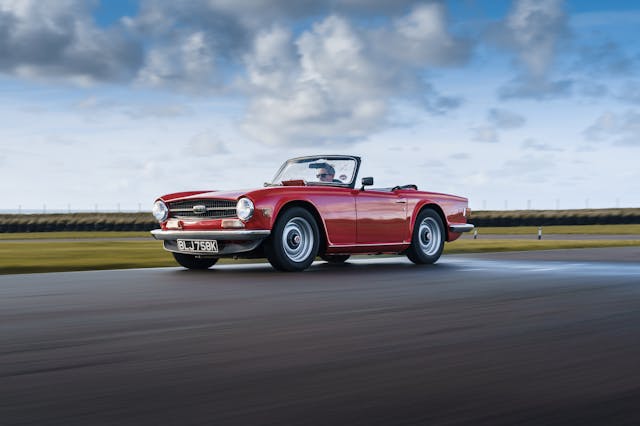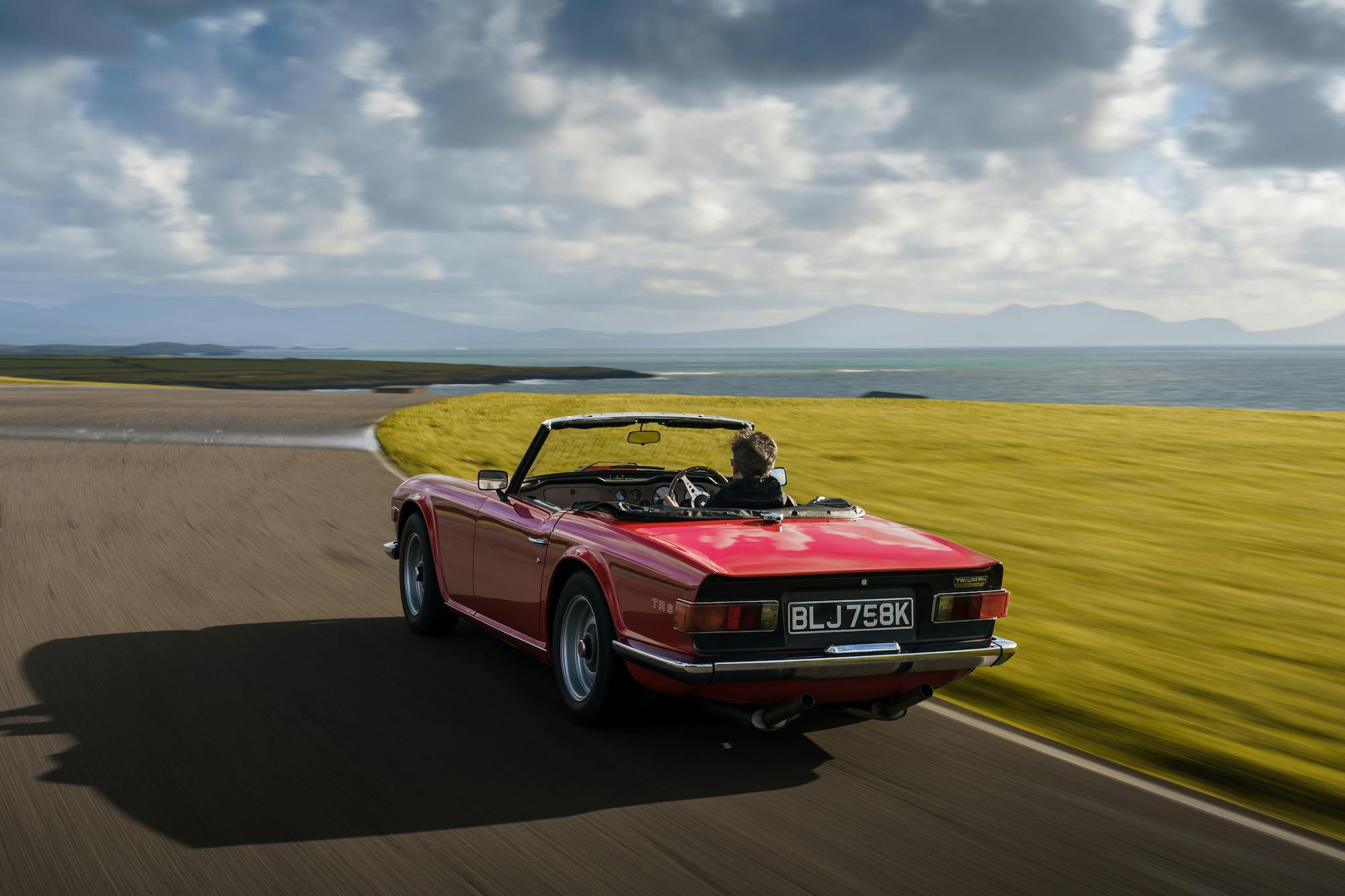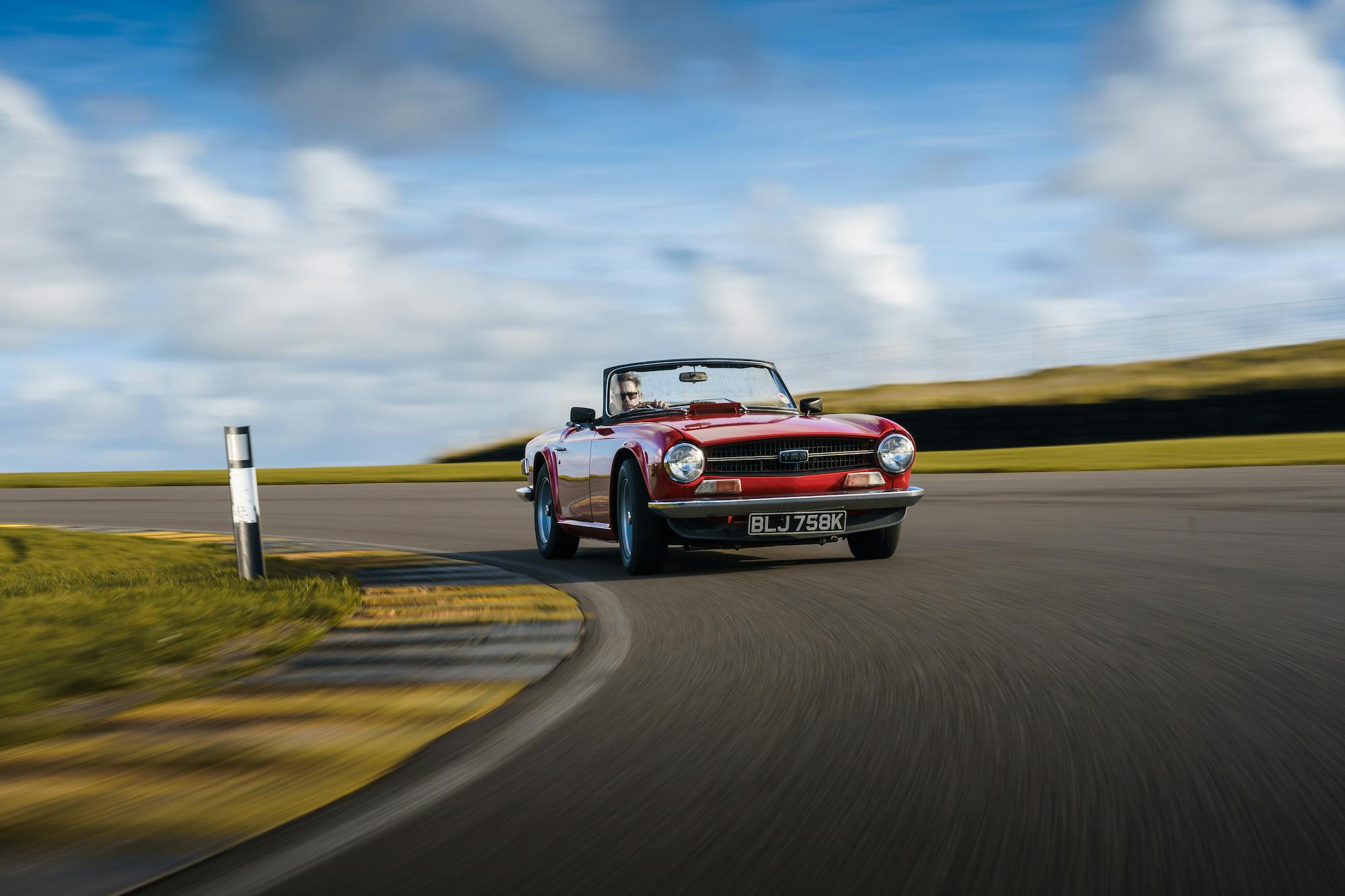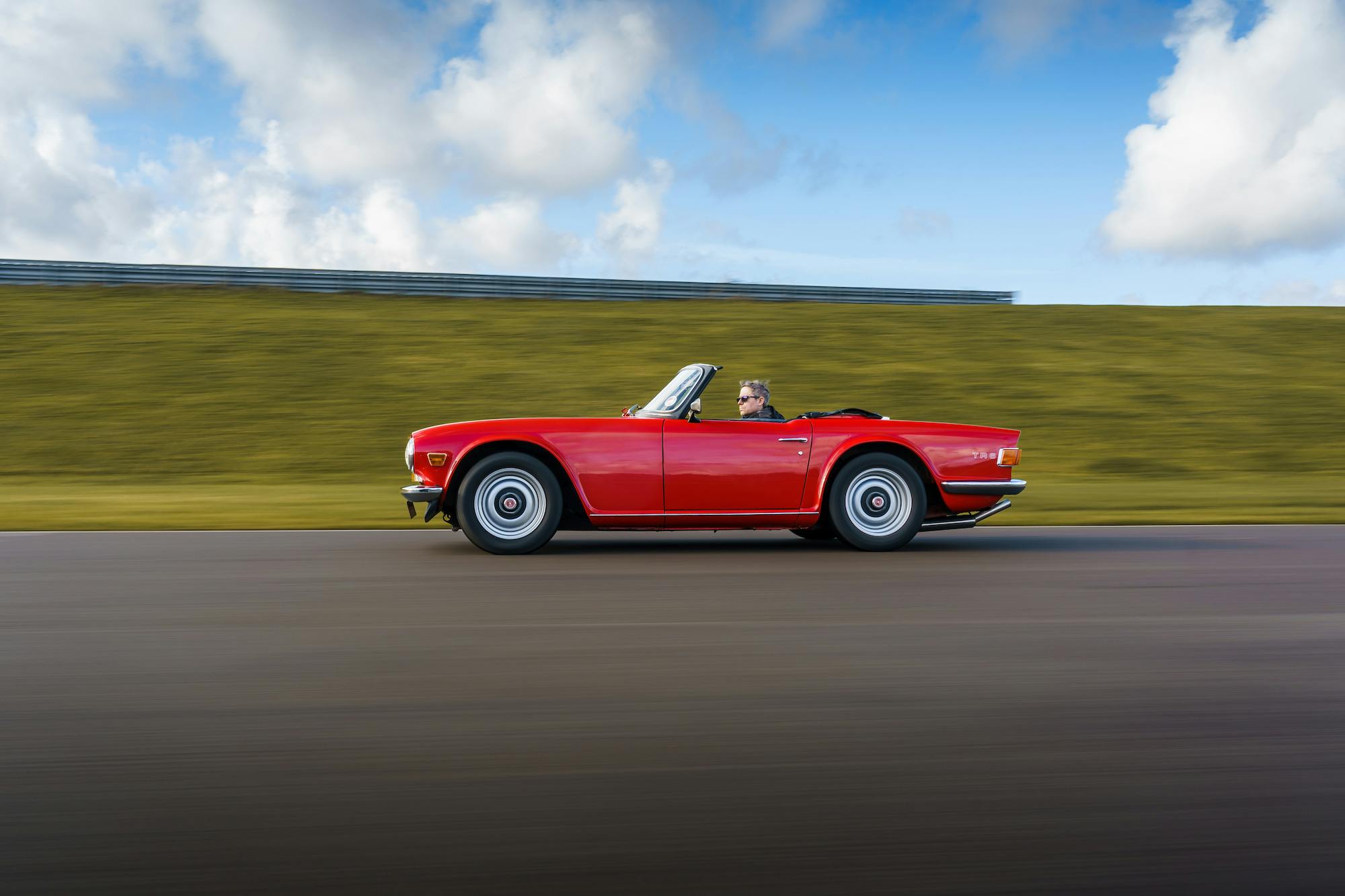Media | Articles
Triumph’s TR6 is an E-Type for the masses
Often overlooked for more dramatic marques, Triumph’s intriguing range of TR sports cars actually enjoyed a glorious 28-year run. The journey began with 1953’s cutaway-door TR2 cutie and finished with the aggressive wedge-shaped TR8 of 1981—seven nameplates and over a dozen distinct models in all. Among these, the 1969–76 TR6 occupies a sweet spot of classic design, ample performance, comfort, serviceability, and affordability.
The silky 2.5-liter inline-six deserves much credit for delivering admirable torque and a seductive baritone song. In its June 1970 “Four Sports Cars” review, Road & Track commented, “The strong, beautiful-sounding engine of the TR6 makes it one of the easiest and most enjoyable cars to drive.”
Such praise, along with four-wheel independent suspension, rack-and-pinion steering, power front disc brakes, and an observed 109-mph top speed made the TR6 a genuine player in the day.

Yet despite its ideal 51/49 percent front/rear weight distribution and a respectable 0.68 g skidpad performance, Road & Track went on to say that handling was “fine until you encounter rough surfaces—then the car’s extremely dated chassis and suspension make themselves known all too harshly.” But such criticism was fair, because in truth, the TR6 was based on the 1961 TR4’s body-on-frame architecture instead of a contemporary unibody.
Even so, the alluring new TR6 offered more than previous Triumphs. From the TR2 through the 1967 TR4A and TR4A IRS (independent rear suspension), all TRs had four-cylinder engines ranging from 2.0 liters to 2.1 liters. Body designs started with the bug-eyed TR2 and TR3 before stepping up to smart Michelotti styling on the first TR4. In 1968 came the one-year-only TR250—a TR4A IRS with a 104-hp long-stroke six from Triumph’s 2000 sedan. This finally gave way to the 1969 TR6, essentially a TR250 with a revised frame and new Karmann bodywork offering crisper lines, a larger trunk, and a decisive Kamm tail in lieu of the nascent tailfins of previous TRs.
Marketplace
Buy and sell classics with confidence
Sports cars were getting faster, and clearly an ancient four-pot wouldn’t cut it. With Austin-Healey’s 3000 axed for 1968 and Alfa Romeos, Fiats, and most MGs still sporting four cylinders, the new Triumph slotted into a good market position. It worked, and by the end of production, the TR6 spanned seven model years, with 76,470 examples exported to the U.S.
In period, an optional removable hardtop, air conditioning, and electric overdrive made the TR6 viable for commuting, touring, and rallies. Additionally, Bob Tullius claimed four SCCA C Production national wins in a race-prepared Group 44 entry from 1969 to 1971.

Today’s buyers should know that British Leyland, which owned Triumph at the time, wasn’t exactly revered for build quality, that TR6s are rust-prone if not protected, and that generally, 1969 through 1971 models are considered the purest. Thereafter, ever more complex emissions controls included a carbon canister in 1972, an anti–run on valve in 1973, a super-low 7.5:1 compression ratio in 1974, and an air-injection system from 1975 on. If this wasn’t bad enough, large rubber “baby buggy” bumpers, added for ’75, further diluted the Scotch.
Despite such early federalization losses, though, in hindsight, TR6s from all model years are wonderfully straightforward and honest sports cars. And thanks to good aftermarket support today, there’s no reason a solid example can’t last a lifetime.
1972 Triumph TR6
Engine: 2.5-liter OHV I-6
Power: 106 hp @ 4900 rpm
Torque: 133 lb-ft @ 3000 rpm
Weight: 2156 pounds
0–60 mph: 10.7 sec
Price when new: $3275
Hagerty #3 (Good) condition value: $13,500–$22,100
This article first appeared in Hagerty Drivers Club magazine. Click here to subscribe and join the club.
Check out the Hagerty Media homepage so you don’t miss a single story, or better yet, bookmark it.





























I like these cars. Great spot for a motor transplant and relatively affordable.
Always wanted a Tr6… In 1973 I was restoring a ’62 MGA 1600 Mkll because i didn’t have budget for a Tr6… sold the MG in 2000 after 27 years of trouble free enjoyment. So in 2018 I bought a pretty nice Tr6 … having never even ridden in one. .. after all, how different can it be ? Well… the differences could not be more stark.. the Tr was unpleasant… drove it maybe 50 miles in rural settings to photograph it.. and sold it for breakeven including freight and sales tax. Whew…
Specifically, interior was narrower than the MG.. (yes, I’m wider) and that ignition placement.. wow.. but the handling.. plenty of power… poorly applied. I tried to like it… just couldn’t get there..
P.S. it was a 72 Tr6… before all the gov’t mandated engine nonsense..
PCChuck,
As I neared retirement, my first entry into SBCs was a ’73 MGB which I owned for about 4-5 years. However, I found myself longing for a bit more zip / power. I ended up with a beautiful ’63 TR4 (mechanically quite similar to a TR6, but w a 4 cyl).
As you say, on my first long drive I realized, that compared to the MG, the TR was much narrower and less roomy, and the ride was quite harsh. But it certainly delivered in the torque and power arena, even with the 2.1 4 cyl engine.
Luckily I’m on the smaller side and I love the torque and grunt of the TR, despite the rougher ride. Now, four years later, I still own and enjoy putting the TR through its paces.
In my college years in the summer of ‘77’ I drove the boss’s TR6 — mainly to fuel it up for him or get it washed. Normally I drove the company Chevy wagon. While I am and always will be a car guy, and while the TR6 was a ton of fun to drive, that Chevy wagon handled better, accelerated faster and had super cold GM a/c. I’ll take the TR6 any day!
The carbon cannister in 1972 was a good thing, effectively dealing with the VOC emitted by the fuel in carburetors, fuel tank and absorbing much of the engine crankcase breathing with a passive charcoal adsorption system. And when I say passive, it robbed the engine of no power, and only added a couple of pounds to the entire vehicle.
My wife bought a ‘75 off the showroom floor in Fort Wayne, IN. To make a very long story short; it has followed us from homes in Indiana to Alaska, back to Indiana, down to Florida and recently back to Indiana for what I believe will be its final move. It has been on road trips across a huge portion of the country. The only time it ever failed us was after its rebuild in ‘09 when I did not put enough gas in the tank to get to town. We have enjoyed it over the years and hope to get a few more trips in next summer. Removed the EGR, and those funky rubber bumper things but is otherwise stock.
Wanted an XKE, a coupe actually, but it wasn’t financially feasible after I retired. Went for the TR6 and it’s been really nice. My other car toy is a MGB GT, with a supercharger, if I ever get the restoration finished. I drive the TR within it stock limits and really enjoy it, but have seen guys drop a ton of money is engine and suspension mods, which would still get its clock cleaned by a stock Miata.
These cars were designed for leisurely English countryside drives. Period. They were up to American road standards up until about the ’70’s. The many I have seen at Cars and Coffee events are either survivors (rust, dents, etc.) or highly updated/rebuilt. All have owners that have had personal experiences learning how to fix various parts (mechanical, electrical, convertible tops). They have learned a lot about English mechanics and their “special English traits”. Lastly, “E-Type for the Masses” – I think not. Only if you squint real hard and click your heels together.
These days, I think people look at you differently if your driving an E-Type vs. a TR6.
Women love my ’70 OTS E-type, but guys tend to look at you differently. Kinda like you’re trying to be a bit showy. Friends in their TR6s, and I myself included, see the TR6 as a ‘Sport’. You know, one of the Gang. Affordable and all about having Fun!
I had a ’67 TR4A and I loved it. My children were small, Daughter in front seat with me and Son in the back.
Had it for 6 years, until son was to big to ride in back. Wish I’d have kept it.
In 1980, I sold my ’73 MGB to buy a ’73 TR6 to be my daily driver. I loved that MG and had driven it back and forth from Boston to Chicago many times, but it was getting tired. The TR6 was such a step up in power and it had a hardtop. I kept it for about 15 years and had so much fun with that car. I still find myself looking for another one.
I always loved the TR6, the looks and sound. When I got my driver’s license in 1975 the first car I looked at, hoping to buy, was a 1970, it was already rusty so I passed.
Over the next couple of decades I looked at a few others, never pulling the trigger.
Finally, in 1996, I found one only about 5 miles from my house that was a keeper, 43k original miles and beautiful original paint.
Over the years I’ve replaced the original soft top that had gotten stiff and the original rubber, tires, windshield rubber, door belt rubber, etc.
Still a beautiful car that gets lots of thumbs up.
https://youtu.be/uREWcBOQXLQ
The irony here is that everyone claims the straight six was such a huge upgrade in power, but the 2.1L four cylinder in my TR4A was rated at almost the exact same horsepower and torque.
I have owned 2 TR6’s. They are great platforms to build upon. If you go the “stock” route, the performance is modest and they are fun to drive. If you go down the rabbit hole like I did, the sky is the limit. There are plenty of aftermarket goodies to make your six go really freaking fast. If you decide to go this route, understand the rear differential is not very forgiving if you make a big increase on the hp at the wheel. Also, be sure to inspect, repair, and reinforce the frame. The metal is not good and becomes swiss cheese over time leading to frame flex and failure. In my opinion, it is a great vehicle for those with jag tastes and a budweiser budget.
I found a fuel injection add on that wiĺl bring the hp to around 220
…that would be fun !!!!
Pricey thuo, around 2000.